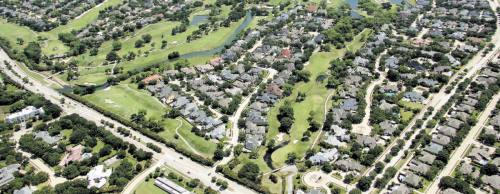 As global corporations like Toyota Motor North America, Liberty Mutual Insurance and JPMorgan Chase & Co. lure more people to the Plano area with the promise of high-paying jobs, home values have significantly increased in the last decade.
As global corporations like Toyota Motor North America, Liberty Mutual Insurance and JPMorgan Chase & Co. lure more people to the Plano area with the promise of high-paying jobs, home values have significantly increased in the last decade.
From 2007-16, new home values in Collin County increased by approximately 43 percent and new home values in Plano increased by approximately 26 percent, according to data from Residential Strategies Inc., a residential market research company based in Dallas. This increase is due in part to out-of-state buyers, Collin County real estate agents have said.
The number of homes for sale remains below the industry standard of a “balanced” market, according to Jonna Fernandez, chief operating officer for the Collin County Association of Realtors.
A market is considered balanced if the inventory of area homes on the market on a given day would last six months before selling out. Anything less than six months’ inventory is considered a seller’s market and anything more is considered a buyer’s market, she said.
Plano is among the North Texas communities that are in a seller’s market, Fernandez said.
And while that is good news for sellers, those relocating to Plano can expect to pay a premium due to the limited amount of supply.
Across four of the five Plano ZIP codes, median home sale prices increased—some of them in June reaching as high as a nearly 20 percent increase compared to the same time last year, according to data from the Realtor association.
Such was the case for the 75075 ZIP code, which is one of the southern most ZIP codes in the city. Compared to its $272,500 monthly median home sale price in June of 2016, the median price jumped to $326,000 by June 2017, according to the data.
 The ‘California effect’
Competitive bids from out-of-state homebuyers have been driving up prices, particularly from states like California, said Marvin Jolly, the regional vice president for the Texas Association of Realtors and broker associate with Keller Williams Realty.
The ‘California effect’
Competitive bids from out-of-state homebuyers have been driving up prices, particularly from states like California, said Marvin Jolly, the regional vice president for the Texas Association of Realtors and broker associate with Keller Williams Realty.
According to a 2015 study by the U.S. Census Bureau, 65,546 Californians moved to Texas, which is nearly  double the number of residents relocating from Florida, the second-highest contributing state on the list.
double the number of residents relocating from Florida, the second-highest contributing state on the list.
Because many Californians are moving out of state for new jobs, which are likely high-paying and require an identified skill, state demographer Lloyd Potter said many of these out-of-state homebuyers can also be expected to be highly educated.
“They are educated buyers who make decisions quickly who are operating in the price range of [$700,000 to $1 million],” Jolly said.
But comparatively higher salaries are not the only reason Californians have more money to spend up front.
“They are much more likely to show up here … with more equity that they can put into a house,” Potter said, noting how the home values appreciated significantly more in California after the Great Recession.
In some cases, buyers are having to compete with other buyers to be able to purchase the home they want—frequently resulting in homes with multiple offers, Fernandez said.
And as bidding wars ensue, homeowners are selling their homes for more than their asking price in some situations, Jolly said.
“We are seeing multiple offers over $1 million,” Jolly said. “That is a ‘California effect.’ That is something we have not seen recently, until this point.”
But even for Plano residents who are not selling their homes, the price hikes could have implications when it comes to property taxes.
Appraisals and tax bills The instances of home appraisal protests in Plano have increased by over 15 percent in the last year, according to records from the Collin Central Appraisal District.
“[Protests] have always been the trend if market value appraisals increase,” district Chief Appraiser Bo Daffin said.
To lower what they pay on property taxes, a resident can protest the district’s appraisal of their home, which would go before a review board, Daffin said.
But in a seller’s market, residents might have a hard time paying the same in taxes as they would in a more balanced market.
Because the district accounts for regional home sales when appraising properties, an increase in home sale prices effectively influences appraisal values, Daffin said.
But rising appraisals may not always translate to higher tax bills, Daffin said. Tax rates, like appraisals, are subject to change any given year—not to mention the homestead exemptions both Collin County and the city of Plano offer their residents.
Although Plano appraisals are subject to change due to the increasingly competitive housing market, some out-of-state buyers are looking elsewhere in North Texas to meet their specific preferences.
 Searching elsewhere
Jolly identified three main qualities California buyers often seek in a home: the location offers an easy commute to work, a large plot size and a house that was built within the last five years.
Searching elsewhere
Jolly identified three main qualities California buyers often seek in a home: the location offers an easy commute to work, a large plot size and a house that was built within the last five years.
However, the Plano housing market is having a difficult time meeting these needs as new single-family residential developments are scarce compared to those of surrounding cities.
For example, Frisco and McKinney saw 595 and 386 housing units built between 2014 and 2015, respectively, according to U.S. Census surveys. Plano saw only 203 new housing units built.
Jolly said the home preferences of California buyers are often best met in the areas outside of Plano, including Prosper, Lovejoy and Frisco.
Fernandez has noted a similar trend of residents moving outside of Plano.
Californians are not only moving to Plano, but also northern areas, Fernandez said, noting some of the same cities as Jolly, such as Prosper and Frisco.
“Initially [Californians move] for a job … then they start to look at quality of schools and quality of life,” Jolly said.
While Plano may not be producing new homes at the same rate as surrounding cities, Fernandez said a recent trend has been the construction of mixed-use projects—where developers blend retail stores with residential and office components—such as the Shops at Legacy and Legacy West.
Some Californians may not be finding exactly what they want in Plano, but more out-of-state buyers moving to Collin County come from California than from any other state, according to the Census Bureau.
Even though a large number of Texans are also moving to California, to the tune of 41,713 in 2015, Texas will continue to benefit from net migration patterns for years to come, Potter said.





